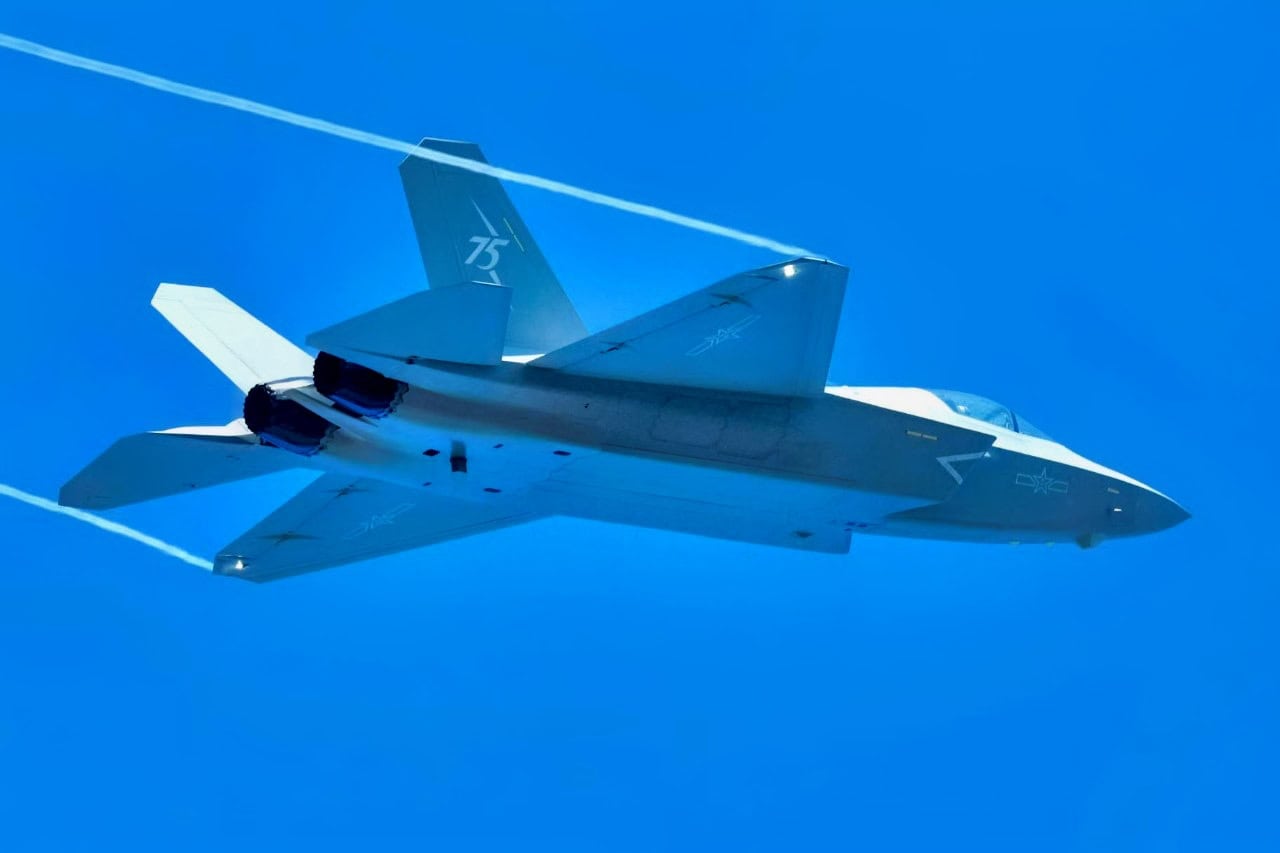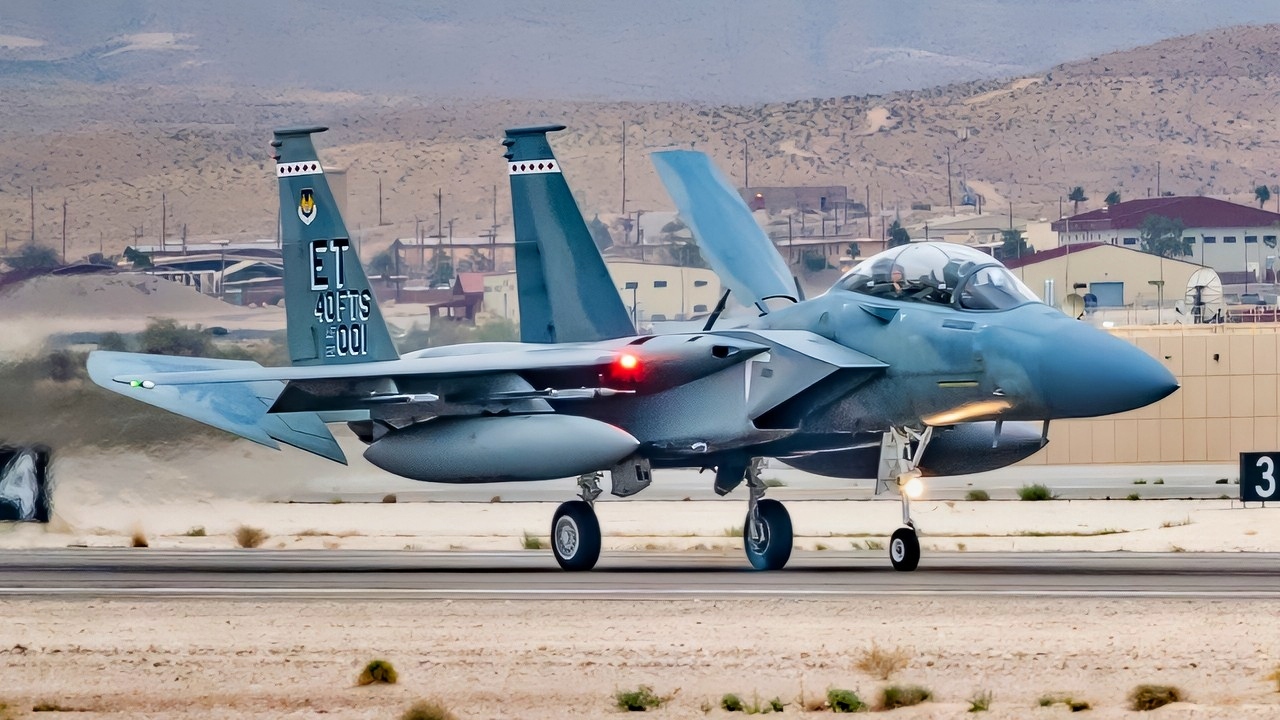Key Points and Summary – China’s J-35 leans hard into low observability: internal bays, DSI inlets, canted tails, and sensor fusion for a “first look, first shot” edge in BVR. The U.S. F-15EX flips the script with brute capacity and brains—APG-82 AESA, IRST21, EPAWSS—and sheer kinematics, carrying a wall of missiles at Mach 2-plus and 60,000 feet.

J-35 Fighter. Image Credit: Chinese State Media.
-On paper, the J-35 likely opens the dance in BVR; the Eagle II’s passive sensors, jamming, and tactics aim to blunt that first volley and counter.
-If it collapses to WVR, the F-15EX’s thrust, energy, and magazine depth tilt the fight. Caveat: many J-35 specs remain unverified, and real outcomes hinge on networks, AWACS, and tactics.
F-15EX Eagle II vs. China’s Brand New J-35
The J-35 is China’s latest fifth-generation stealth fighter that was officially accepted into PLAAF service earlier this month.
It was derived from the FC-31 Gyrfalcon tech demonstrator, which was meant for export orders until the PLAAF took interest in the concept.
The F-15EX Eagle II, meanwhile, is a heavily upgraded version of the venerable F-15.
F-15EX replaces most of the fighter’s original avionics with new state-of-the-art sensors and equipment.
Additionally, it boasts better flight controls and other frame upgrades to make it more resilient and reliable. But how would it fare in a fight against China’s newest stealth fighter?
The F-15EX vs China’s Newest Stealth Fighter
The F-15EX is built around the concept of overwhelming firepower, speed, and survivability. It is not stealthy, but it compensates with a massive payload capacity, advanced electronic warfare systems, and powerful radar. Capable of carrying up to 22 air-to-air missiles, including long-range standoff weapons like the AGM-158 JASSM.
The F-15EX is designed to dominate in open combat and serve as a force multiplier in networked warfare environments. Its top speed exceeds Mach 2.4, and it can operate at altitudes up to 60,000 feet, giving it superior kinetic performance compared to most modern fighters.

Lt. Col. Richard Turner, 40th Flight Test Squadron commander, pilots the F-15EX, the Air Force’s newest fighter aircraft, to its new home at Eglin Air Force Base, Florida March 11. The aircraft will be the first Air Force aircraft to be tested and fielded from beginning to end through combined developmental and operational tests. The 40th FLTS and the 85th Test and Evaluation Squadron personnel are responsible for testing the aircraft. (U.S. Air Force photo/Samuel King Jr.)
The J-35, on the other hand, is a stealth-centric design. It features a blended wing-body configuration, canted vertical stabilizers, and internal weapons bays that reduce its radar cross-section. Its diverterless supersonic inlets and radar-absorbent materials further enhance its stealth profile.
The J-35 is equipped with an electro-optical targeting system and infrared search and track capabilities, allowing it to detect and engage targets passively. While its top speed is lower than the F-15EX, estimated at around Mach 1.8, and its combat range is shorter, the J-35’s stealth and sensor fusion give it a significant advantage in beyond visual range (BVR) combat.
Stealth Capabilities
Stealth is not the be-all, end-all that many presume it is, but it certainly helps a lot. The J-35 is built from the ground up as a fifth-generation stealth fighter, featuring a low observable airframe with internal weapons bays, radar-absorbent materials, and carefully shaped surfaces to minimize radar cross-section.
Its diverterless supersonic inlets and canted vertical stabilizers further reduce its radar signature, making it difficult to detect in beyond visual range combat.
In contrast, the F-15EX is not a stealth aircraft; it retains the conventional design of the original F-15, with large external weapons pylons and a prominent radar cross-section. While it incorporates advanced electronic warfare systems like EPAWSS and passive sensors such as IRST to help detect stealthy adversaries and reduce its vulnerability, it cannot match the inherent low observability of the J-35. Thus, in terms of stealth, the J-35 holds a clear advantage.
Avionics and Internals
In terms of avionics, the F-15EX is equipped with the AN/APG-82 AESA radar, the IRST21 infrared sensor pod, and the Eagle Passive/Active Warning Survivability System (EPAWSS), which provides advanced electronic warfare capabilities.
It also features the Advanced Display Core Processor II, one of the most powerful mission computers ever installed in a fighter jet. These systems allow the F-15EX to operate as a command-and-control node, coordinating with other assets in a joint force environment.
Unfortunately, when it comes to the J-35’s electronics and internals, all we can do is speculate. It is believed to include a Chinese-developed AESA radar, helmet-mounted displays, and sensor fusion capabilities similar to those found in other fifth-generation fighters like the F-22 and J-20. Its internal weapons bays can carry up to six air-to-air missiles, typically the PL-15E for long-range engagements and the PL-10 for short-range combat. While it can carry external stores, doing so compromises its stealth profile.
Engine Performance
The F-15EX is powered by two General Electric F110-GE-129 engines, each producing around 29,500 pounds of thrust, giving it exceptional speed, acceleration, and a top speed exceeding Mach 2.4. This high thrust-to-weight ratio allows the F-15EX to climb rapidly, maneuver aggressively, and carry heavy payloads without sacrificing performance.
Comparatively, the J-35 is believed to use either the WS-13X or the more advanced WS-21 engines (sources vary), each generating approximately 21,000 pounds of thrust. While sufficient for supersonic flight and agile maneuvering, the J-35’s engines do not match the raw power of the F-15EX.
However, the J-35 compensates with a lighter airframe and stealth-optimized design, prioritizing low observability and efficiency over brute force. As a result, the F-15EX holds the edge in raw engine performance, while the J-35 leverages its engines to support stealth and agility in a more constrained power envelope.
Who Wins in 1 Word: Stealth?
In a BVR encounter, the J-35’s stealth would likely allow it to detect and engage the F-15EX before being seen.
Its PL-15E missiles, which are believed to have a range comparable to or exceeding the AIM-120 AMRAAM, could give it a “first look, first shot” advantage. However, the F-15EX’s IRST and electronic warfare systems might allow it to detect the J-35’s emissions or heat signature, enabling it to evade or counterattack.
In a within visual range (WVR) dogfight, the F-15EX would likely have the upper hand due to its superior thrust-to-weight ratio, maneuverability, and missile load. Its ability to carry a large number of AIM-9X Sidewinders and its high-speed performance would make it a formidable opponent. The J-35’s agility and helmet-mounted sighting systems could help level the playing field, but its smaller payload and lower thrust would be limiting factors.
About the Author: Isaac Seitz
Isaac Seitz, a Defense Columnist, graduated from Patrick Henry College’s Strategic Intelligence and National Security program. He has also studied Russian at Middlebury Language Schools and has worked as an intelligence Analyst in the private sector.
This piece has been updated since publication to fix a naming mistake.
More Military
The New B-21 Raider Is Far More Than Just A ‘Stealth Bomber’
The ‘New’ Arleigh Burke–Class Flight III Destroyer Has a Message for the U.S. Navy
France’s Mirage 2000: The Best Fighter You Never Heard of Fighting Putin in Ukraine
The SR-71 Blackbird Changed the U.S. Military Forever
SR-72 Darkstar: Why Won’t the Air Force Show Us This Mach 6 Plane?











Sam
September 16, 2025 at 1:00 pm
Some key mistakes in the article. That’s why I don’t read the propaganda hit pieces of western journalists because they try to emphasize bravado more than facts.
1- J35 uses PL 17 missiles with longer range
2- E designation is for export version and China won’t be using the export version and will have longer range and more capabilities.
Those were some quick errors I found. There could be more.
Kim Kaufman
September 17, 2025 at 9:03 am
When was the F-15 Eagle renamed “Falcon”?